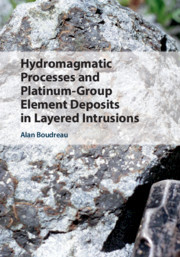Description
Hydromagmatic Processes and Platinum-Group Element Deposits in Layered Intrusions
Author: Boudreau Alan
A comprehensive overview of the evidence for fluid-crystal-liquid (hydromagmatic) interactions in layered intrusions, for academic researchers and professional geologists.
Language: English
Subject for Hydromagmatic Processes and Platinum-Group Element...:
Approximative price 135.14 €
In Print (Delivery period: 14 days).
Add to cart
Publication date: 03-2019
286 p. · 17.8x25.3 cm · Hardback
286 p. · 17.8x25.3 cm · Hardback
Description
/li>Contents
/li>Biography
/li>
The role of hydrothermal fluids during the crystallization of layered intrusions and the ore deposits they contain has long been debated. This book summarizes the evidence for fluid-crystal-liquid (hydromagmatic) interactions and their importance for the understanding of the formation of platinum-group deposits in layered intrusions. It discusses the composition of igneous fluids in mafic magmatic systems, the generation and movement of these fluids in layered intrusions, their impact in altering the mineralogy and composition of the originally precipitated assemblages, and their role in the transport of the platinum-group elements (PGE). Using examples from the Bushveld complex of South Africa and other intrusions, this book provides a comprehensive overview of the hydromagmatic model for the origin of various features of layered intrusions. It is a useful reference for academic researchers and professional geologists working on economic mineral exploration, layered igneous intrusions, and hydrothermal metallogenesis.
Preface; 1. Introduction; 2. Layered intrusions: an overview; 3. Magmatic volatiles and fluids; 4. Geochemistry of the platinum-group elements; 5. Generation and movement of bubbles and volatile fluids in a crystal-liquid mush; 6. Halogens in layered intrusions; 7. Melt and fluid inclusion evidence; 8. Pegmatoids, pipes, and potholes; 9. The effects of volatiles on mineral stability and volatile fluxing; 10. Chromatographic effects; 11. Compaction-driven stratigraphic traps and the formation of Great Dyke-type deposits; 12. Chromitites; 13. Isotopic evidence; 14. Some objections considered; References; Index.
Alan Boudreau is Professor of Geology at Duke University, North Carolina and an expert on the origins of layered intrusions. He has worked on numerical modeling of crystallization processes such as crystal aging and compaction, and how they give rise to the variety of features observed in these intrusions. He is also interested in the role of igneous fluids in the petrogenesis of platinum-group element (PGE) deposits in layered intrusions, including the understanding of interaction of igneous fluids with liquid-crystal assemblages to produce the observed features.
© 2024 LAVOISIER S.A.S.




